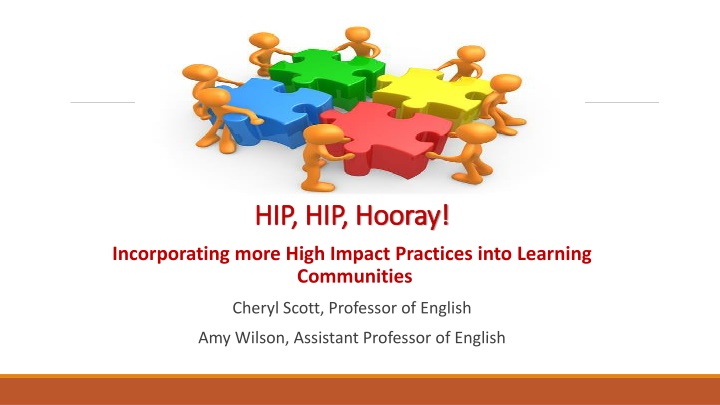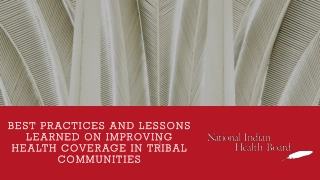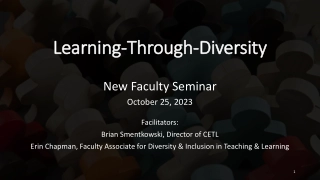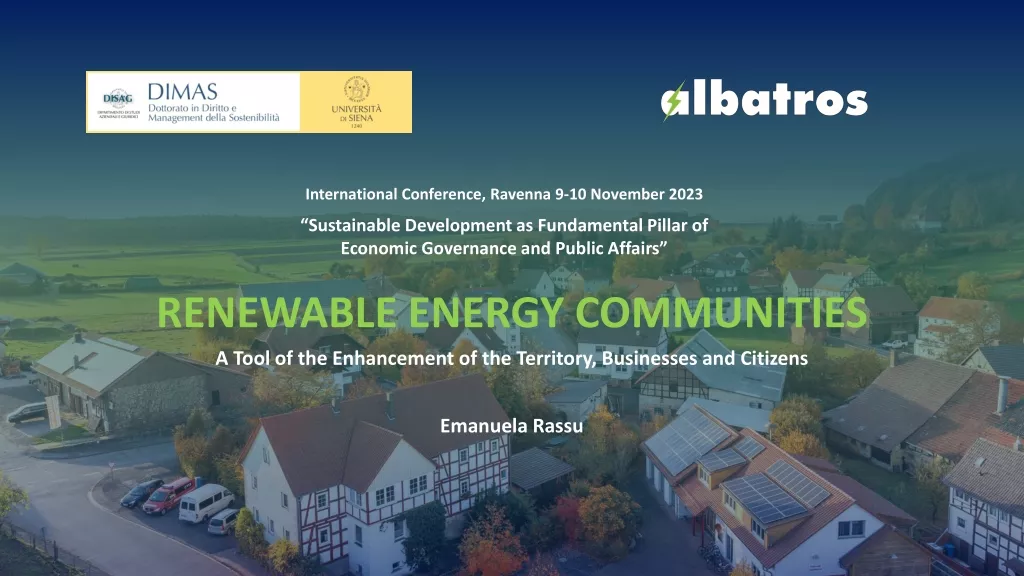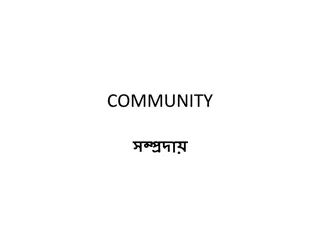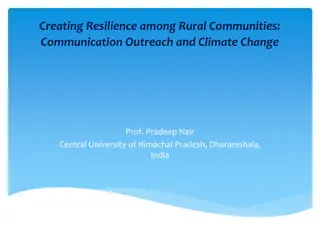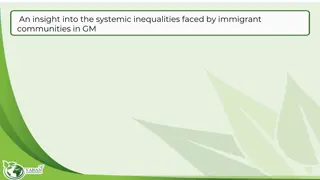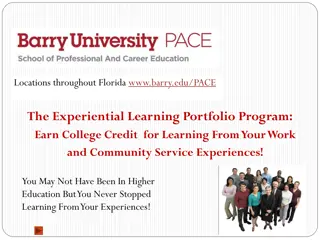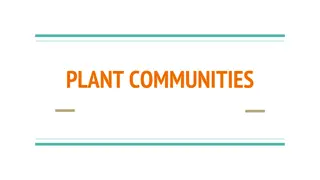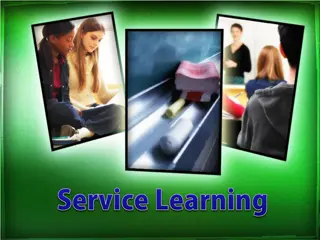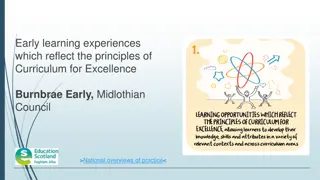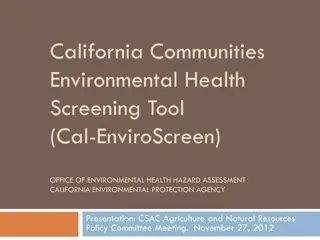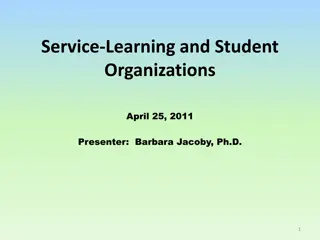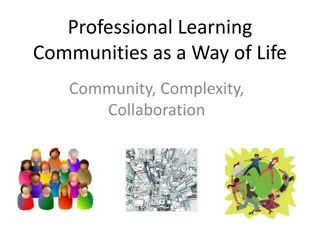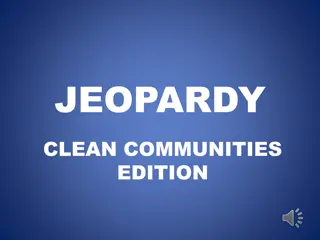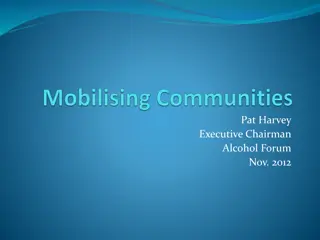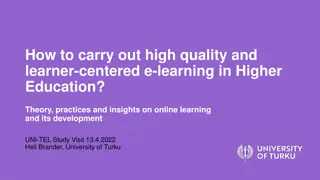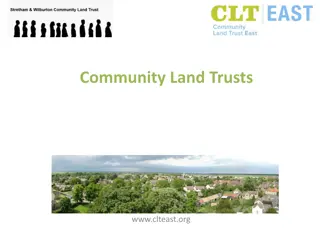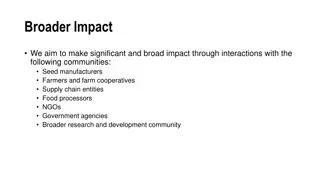Enhancing Learning Communities Through High Impact Practices
Incorporating high impact practices into learning communities can significantly benefit college students, particularly those from historically underserved backgrounds. Learning communities offer an integrated approach to teaching and learning, fostering student engagement, success, and retention. By integrating courses and promoting collaboration among students and faculty, learning communities create a supportive environment for deepening understanding, critical thinking, and interdisciplinary learning experiences.
Download Presentation

Please find below an Image/Link to download the presentation.
The content on the website is provided AS IS for your information and personal use only. It may not be sold, licensed, or shared on other websites without obtaining consent from the author.If you encounter any issues during the download, it is possible that the publisher has removed the file from their server.
You are allowed to download the files provided on this website for personal or commercial use, subject to the condition that they are used lawfully. All files are the property of their respective owners.
The content on the website is provided AS IS for your information and personal use only. It may not be sold, licensed, or shared on other websites without obtaining consent from the author.
E N D
Presentation Transcript
HIP, HIP, Hooray! HIP, HIP, Hooray! Incorporating more High Impact Practices into Learning Communities Cheryl Scott, Professor of English Amy Wilson, Assistant Professor of English
High High- -Impact Practices Impact Practices Teaching and learning practices have been shown to be beneficial for college students from many backgrounds, especially historically underserved students, who often do not have equitable access to high- impact learning. Learning Communities Collaborative Assignments and Projects Diversity/Global Learning Undergraduate Research Service Learning, Community-Based Learning Writing-Intensive Courses First-Year Experiences (Academic Development courses) Common Intellectual Experiences Internships ePortfolios Capstone Courses and Projects
What is a Learning Community? What is a Learning Community? An integrated approach to teaching and learning. In a learning community, two or more classes are paired, and a group of students enrolls in both of the paired courses. Faculty work together to integrate course content and materials in order to emphasize the connections between the subject areas. Because students take the same classes together, strong bonds form as they study together, support each other, and learn from one another. A High Impact Practice (HIP) that increases student engagement, student success, and student retention (George Kuh, AAC&U, 2008).
Broad Purposes Broad Purposes Offer students a more integrated learning experience Greater curricular coherence and Increased collaboration of students and faculty More supportive learning environment Peer bonding Student faculty bonding Peer mentoring Enrich learning experiences Integrative assignments Active learning activities
Learning Community Objectives Learning Community Objectives: : Acquire deeper understanding of both subjects Understand relationships between the different subjects Think critically and analytically Deal with complex problems that have multiple perspectives Be personally accountable for learning Feel supported by teachers and peers Work effectively with others Learn effectively on one s own
What is Integrative Learning? What is Integrative Learning? Capacity to integrate knowledge and modes of thinking from two or more disciplines in order to produce a cognitive advancement -to explain phenomena, fashion products, solve problems, in ways that would have been unviable through a single disciplinary means. (Veronica Boix- Mansilla). Builds the capacity to use knowledge rather than just accumulate knowledge.
Strategies for Integration Strategies for Integration Visit each others classes periodically to observe or participate in class activities. Communicate weekly with each other to plan activities and discuss student behaviors, progress. Meet with each student for midterm conferences as a team. Participate in research efforts. Design integrative assignments that meet course objectives from both courses. Revise syllabi to reflect connections between the courses and course content. Use fiction and nonfiction readings with common themes. Create common themes (ex. Cultural & Global Issues. )
Benefits: Students Benefits: Students CCBC s LEARNING COMMUNITIES are HIP! Learning communities can have a high-impact on student outcomes through the integration of learning across courses and disciplines (LEAP). Offers an integrated learning experience: Assignments Syllabi Policies Helps understanding of relationship between different subjects and disciplines Provides opportunities to think critically and analytically. Encourages personal accountability for learning. Provides enriched and supportive learning experience: Work collaboratively with others Forms close bonds with faculty and peers
Benefits: Faculty Benefits: Faculty Creates Partnerships. Develops self-awareness of one s own teaching. Places more attention on delivery systems. Uses more collaborative learning techniques. Develops more compassion for students. Encourages faculty to be more flexible. Encourages students to take more responsibility for learning. Offers opportunity for professional development. Stipends for extra responsibility and time spent on professional development.
Combining HIPs: Team Teaching Team Teaching Integrated Material & Assignments Integrated Material & Assignments Service Learning Service Learning Portfolio Grading Portfolio Grading ARSC 121: AMERICAN PLURALISM, THE SEARCH FOR JUSTICE ARSC 121: AMERICAN PLURALISM, THE SEARCH FOR JUSTICE ENGL 102: COLLEGE COMPOSITION II, HONORS ENGL 102: COLLEGE COMPOSITION II, HONORS
one syllabus & schedule team teaching through shared instruction for both courses Team Teaching all assignments integrated, including feedback from both instructors portfolio grading
WEEK SEVEN TUESDAY March 17 11:10 12:45 PART III: Complicating Questions of Identity: Race, Ethnicity, and Immigration (211- 214); A Nation of Non and All of the Above (215-216); Impossible Subjects: Illegal Aliens and the Making of America (224-234); For Many Latinos, Racial Identity is More Culture than Color (238-241); The Myth of the Model Minority (248-254). The Bluest Eye THURSDAY March 19 11:10 12:45 PART VI: Many Voices, Many Lives: Issues of Race, Class, and Gender and Sexuality in Everyday Life (407-409); Crossing the Border Without losing Your Past (428-429); The Event of Becoming (430-434); This Person Doesn t Sound White (435-438); Pigskin, Patriarchy, and Pain (448-451); Against Bullying or On Loving Queer Kids (465-467). The Bluest Eye
Texts: Race, Class, and Gender in the United States, 9th Ed. Paula Rothenberg. The Bluest Eye. Toni Morrison. Nickel and Dimed: On (Not) Getting By in America. Barbara Ehrenreich. Integrated Materials Films/Videos: Ethnic Notions Inequality for All Miss Representation
All Assignments shared Essays/Papers (graded by both instructors) BB Discussion Forum based on Readings Service Learning Project: Site Suggestions Requirements for Service Learning Timeline Reflection Essay Integrated Assignments
Incorporates community work into the curriculum Gives students real-world learning experiences that enhance their academic learning while providing a tangible benefit for the community Service Learning
Portfolio Grading Papers/ Portfolio Grading policy: We will use portfolio grading in this course. Although the professors will comment extensively on each of your submitted assignments, we will not assign formal grades to individual assignments during the semester. Instead, you will have the opportunity to revise and refine your written work and then resubmit it in a final portfolio. emphasizes feedback and revision demonstrates skill development The final portfolio must include the originally submitted paper with professors comments along with the revised paper. *Papers not submitted during the semester may not be submitted in the portfolio. highlights themes The portfolio should also include a short cover essay in which you reflect on your writing over the course of the semester. promotes reflection
Global Education: Integrated Material & Assignments Integrated Material & Assignments Intercultural Dialogues Intercultural Dialogues CMNS 101: COMMUNICATION STUDIES CMNS 101: COMMUNICATION STUDIES ENGL 101: COLLEGE COMPOSITION I ENGL 101: COLLEGE COMPOSITION I
Write Talk: A Global Experience CMNS 101: Communication Studies ENGL 101: College Composition I This learning community allows students to fulfill two general education requirements one in English and one in Humanities, with a CCBC Global Designation. Students will sharpen communication skills within a supportive community of learners and explore a common global theme through writing, research, discussion, and oral presentations.
Integrative Material Integrative Material ENGL 101 CMNS 101 In English, students read novels and other short readings related to cultural diversity and complete assignments designed to strengthen skills of analysis and critical thinking In CMNS the assignments from ENGL are adapted for speeches. Students become aware of the differences in presenting information orally and presenting information through writing. Both use similar planning strategies, research, organizing, outlining, and documentation
Integrative Assignments Integrative Assignments ENGL 101 CMNS 101 Cultural Autobiography (must conduct personal interview) Personal culture speech (must incorporate a visual aid). Moral Dilemma Paper Moral Dilemma Speech Summary Response to journal article (research sources to prepare for Research Paper) Sources and summaries from ENGL are used to prepare research speech Research Paper on Human Rights issue Research Speech Human Rights issue
Sample Integrative Assignment Moral Dilemma Essay and Speech Based on the novel The Kite Runner by Khaled Hosseini two choices: Describe an incident in your own life where you, like Amir, faced a moral dilemma where you had to make an important, life-altering decision. How did the decision affect you? What was the lesson you learned? Describe a burden that you carry or have carried. Explain how this burden has affected or changed your life, what were the consequences, and what was the lesson you learned? How have you gained strength from this experience?
Intercultural Dialogues Intercultural Dialogues International/ESOL Students visit classes in various disciplines or speak at campus events. This program facilitates an open exchange between individuals with different cultural backgrounds. Students enrolled in the courses are able to ask the international students questions.
Advantages of Intercultural Dialogs Students learn the meaning of culture, build meaningful relationships, engage in reflection, & challenge themselves to be more culturally relative rather than ethnocentric
Learning Communities and Learning Communities and Academic Development Courses Academic Development Courses ACDV 101: ACADEMIC DEVELOPMENT & ENGL 101: COLLEGE COMPOSITION I ACDV 101: ACADEMIC DEVELOPMENT & ENGL 101: COLLEGE COMPOSITION I ACDV 101: ACADEMIC DEVELOPMENT & ACLT 101: ACADEMIC LITERACY ACDV 101: ACADEMIC DEVELOPMENT & ACLT 101: ACADEMIC LITERACY
The ACLT/ACDV Learning Community The ACLT/ACDV learning community helps students improve their reading and writing skills while fulfilling developmental reading and developmental English requirements. Students will fulfill the ACDV requirement using the materials and assignments from the ACLT 052 course as they develop and strengthen the academic skills needed to become successful college students.
ACDV 101/ ENGL 101: ACDV 101/ ENGL 101: College Consciousness: Exploring the Role of Education in College Consciousness: Exploring the Role of Education in Today s Society Today s Society In this Learning Community students explore the role of education in society and reflect on their own educational goals as well as acquire the knowledge and skills to successfully navigate a variety of educational paths. Students apply ACDV strategies necessary for success in the college environment to master the course objectives in their English Composition 101 course.
contact Information: Cheryl Scott: cscott2@ccbcmd.edu Amy R Wilson: awilson@ccbcmd.edu
